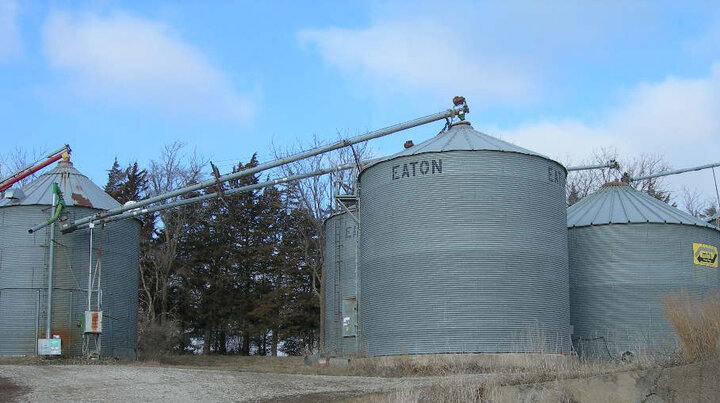After enjoying a generally nice harvest season this year, now is the time for upper Midwestern producers to focus on managing the grain in storage, North Dakota State University's grain handling and storage expert says.

NDSU Extension Service agricultural engineer Ken Hellevang recommends producers check the moisture content of the grain at several locations in the bin because this will determine the management steps needed to preserve the stored grain.
Producers should follow the moisture meter manufacturer's recommendations to obtain an accurate reading. They can verify the meter's reading by warming the grain sample to room temperature in a sealed plastic bag or other sealed container before measuring the moisture content.
Here are other grain management suggestions from Hellevang:
- Check the grain temperature. Warm grain creates conditions conducive for insect infestations. Reducing the grain temperature reduces insect activity; insects in stored grain become dormant below about 50°F. In addition, the allowable storage time, which is related to mold growth, is approximately doubled for each 10 degrees the grain is cooled. For example, cereal grains such as corn at 16 percent moisture content can be stored about 70 days if maintained at 70°F and about 230 days at 50°F. Allowable storage time based on germination is approximately one-half as long.
- Cool stored grain to near the average outdoor temperature during the fall using aeration. Grain temperature should be cooled to within about 20 degrees of the coldest average monthly temperature or below 40°F for winter storage. In North Dakota, with an average January temperature of 7°F, that would be about 20 to 30°F. For Kansas, with an average January temperature of 29°F, the goal is to cool the grain to below 40°F. To estimate the cooling time of 56 pounds-per-bushel grain, divide 15 by the airflow rate. For example, about 75 hours of fan time is required to cool the grain using an airflow rate of 0.2 cubic feet per minute per bushel (cfm/bu). Cooling times of other grain are the ratio of 56 pounds and the grain weight. For example, barley with a weight of 48 pounds per bushel will cool more quickly than corn at 56 pounds per bushel (48 divided by 56 equals 0.86).
- Check stored grain biweekly until it has been cooled to the winter storage temperature. Check and record the grain's temperature and condition at several locations. Temperature history can be used to detect grain warming, which may indicate storage problems. Look for indications of problems, such as condensation on the roof or crusting of the grain surface. Probe to examine grain below the surface.
- Check for insect infestations. Because insects are dormant at colder temperatures, warm grain samples to room temperature and place the grain on a white cloth to inspect for insect infestations. Grain fumigants will not control an insect infestation adequately if some of the grain is cold. The fumigant does not volatize adequately in cool grain and insects in cool grain near the edge of a "hot spot" may have limited metabolic activity, resulting in poor control. However, cooling the grain can control most storage problems.
- Open or unlatch the grain bin's fill or access cover during fan operation to serve as a pressure relief valve. Bin vents may become blocked by frost or ice if fans run when the outdoor air temperature is near or below freezing. The resulting air pressure may damage the bin roof. Cover the aeration fan when it is not operating to prevent pests and moisture in the form of snow, fog and rain from entering the bin.
Hellevang says corn moisture content may be an issue this year. Corn at moisture contents up to 20% was harvested and placed in bins with natural-air drying fans sized to provide an airflow rate of at least 1 cfm/bu. Even though the outdoor temperature and relative humidity were conducive for drying during October, the drying zone may not have moved through all the grain.
The estimated drying time for corn with a moisture content up to 20% is 30 to 40 days with an average air temperature of about 50°F, about 50 to 60 days at 40°F and at least 70 days when the air temperature is near 30°F.
The moisture-holding capacity of the air at temperatures below 35 to 40°F is small, so drying becomes inefficient using natural-air/low-temperature (NA/LT) drying. Drying time also is related to the airflow rate, so at an airflow rate of 0.75 cfm/bu drying time is about 53 days rather than the 40 days at 1 cfm/bu (40 divided by 0.75).
Warming the air by about 5 degrees will allow producers to continue drying corn with the typically higher air humidity level that occurs in November if the outdoor air temperature is averaging at least 35 to 40°F, Hellevang says. Adding more heat causes grain in the bottom of the bin to dry to a lower-than-desired moisture content.
Producers should use a bin-stirring device or do batch-in-bin drying with only a few feet of grain in the bin if the air is heated more than 5 to 10 degrees. NA/LT drying can be completed in the spring starting when outdoor temperatures again average about 40°F.
North Dakota State University News Release
